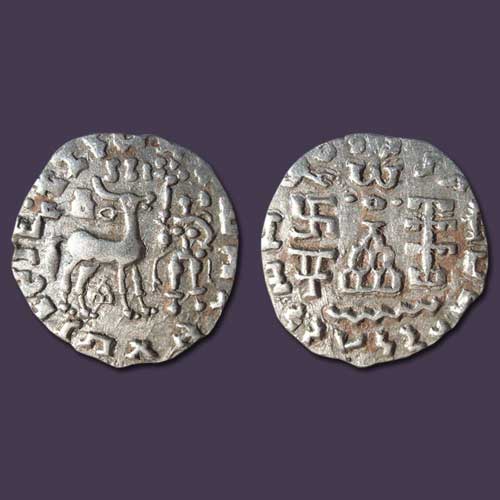The Ancient Kingdom of Uttarakhand
2020-11-09 Mon
The modern state of Uttarakhand existed since the 2nd century BCE with the name Kingdom of Kuninda or Kulinda. Located in the modern state of Uttarakhand and southern areas of Himachal in northern India, the kingdom thrived between 2nd BCE to 3rd CE. On the occasion of the Uttarakhand Foundation day, let’s get acquainted with the coinage of the Kuninda Dynasty.There are two types of Kuninda coinage, the first one issued around the 1st century BCE, and the second around the 2nd century CE. The first coins of the Kuninda were influenced by the numismatic model of their predecessor Indo-Greek kingdoms and incorporated Buddhist and Hindu symbolism such as the Triratna and images of Lakshmi. These coins typically follow the Indo-Greek weight and size standards.
A very large portion of the Kuninda coins is in the name of king Amoghabhuti. These silver coins depict Deer standing facing right, crowned by two cobras, attended by Lakshmi holding a lotus flower. A legend in Prakrit: Rajnah Kunindasya Amoghabhutisya maharajasya ("Great King Amoghabhuti, of the Kunindas").
The reverse depicts a three-arched hill surmounted by the Buddhist symbol Triratna and surrounded by a swastika, a nandipada, and a tree in the railing. A legend in Kharoshti script, from right to left: Rana Kunidasa Amoghabhutisa Maharajasa, ("Great King Amoghabhuti, of the Kunindas").
Image Courtesy: wikipedia.org
Latest News
-
Gold Pagoda of Vijaynagar Empire King Deva Raya I
2024-04-10 WedKing Deva Raya I of the Vijayanagara Empire was a patron of Kannada literature and architecture. He ...
-
Silver Denarius of Septimus Severus
2024-04-05 FriLucius Septimius Severus served as the Roman emperor from 193 to 211 AD. Severus sat on the throne o...
-
Extremely rare 'Malaharamari' type Gold Gadyana of King Guhalladeva-III Sold for INR 611000
2024-04-03 WedTribhuvanamalla, also known as Guhalladeva III, was the ruler of the Kadamba dynasty. His reign coin...
-
90 Years of RBI
2024-04-02 TueOn 1st April, PM #Modi unveiled a special commemorative coin marking 90 Years since the foundation o...
-
Silver Denarius of Julia Mamaea
2024-04-02 TueJulia Avita Mamaea, a Christian Syrian noblewoman, was the mother of Roman Emperor Alexander Severus...

